As we all know, one of the biggest influences and challenges that affects our work in this industry is the weather. The last couple of years we seem to be experiencing unprecedented fluctuations in the severity of conditions.
Saturday 3rd October 2020 was in fact, the wettest day for UK-wide rainfall since records began in 1891 according to Met Office researchers. The downpour followed in the wake of Storm Alex and saw an average of 31.7mm (1.24ins) of rain across the entire UK.
The deluge was enough to exceed the capacity of Loch Ness - the largest lake in the UK by volume. The previous record wettest day was 29 August 1986. Across the globe we have witnessed unusual patterns of weather, with headlines like:
- UK sees sunniest spring on record
- US heat wave leads to 'hottest temperature ever' and firenados
- Warmth shatters section of Greenland ice shelf
It has certainly, been a year of stark contrasts across the UK when it comes to rainfall.
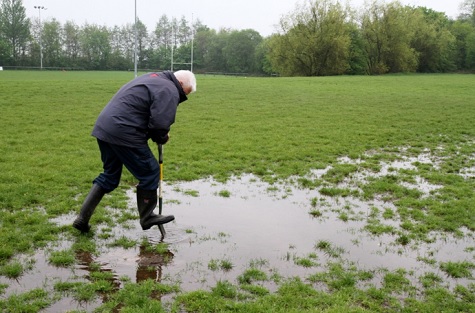
Two named storms, Ciara and Dennis, helped push February to the top of the records as the wettest ever in the UK.
This was followed by a very dry and bright spring that saw May break the record for sunniest calendar month with 266 hours of sunshine. But a middling summer has been followed by a drenching autumn across much of the UK. It will be interesting to see how severe the weather will be during the next four months and how it may impact on the work we do?
As for Covid-19 it seems we are all heading for tough winter of further sanctions and lockdown restrictions. In terms of our industry shows, we have no further clarification on whether next year’s GMA Saltex will be going ahead as currently advertised.
A recent GMA Show survey has been conducted and one would expect that an announcement on the future of the show will be forthcoming. However in light of the current situation, with many parts of the country going into a second serious lockdown, along with the fact that most of the Nightingale Hospitals are being re commissioned, I cannot really see how this and other industry shows will able to go ahead?
Amenity Forum Conference 2020
I was very pleased though, to have attended this year’s virtual Amenity Forum Conference last Thursday 15th October. A truly remarkable feat achieved by John Moverley and his staff. It was certainly a different experience sitting in front of a computer screen for six plus hours.
The Amenity Forum Conference has been for many years, a well-attended conference and annually attracts over 250 plus members. It’s an event which is very well supported by many leading industry manufacturers and service providers.

The Amenity Forum is the UK based, industry led voluntary initiative for the promotion of “best practice” principles within the amenity sector when using pesticides – herbicides, fungicides, insecticides, algaecides and other products to control pests and diseases in our sector.
Membership of the Amenity Forum is open to individuals and organisations involved in weed and pest control in the sector. This year’s theme was “Planning for the Future!”.
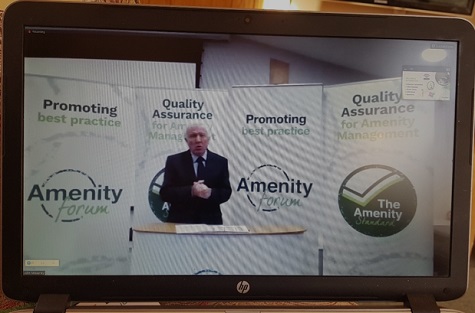
And in John’s own words, “What a difference a year makes! 2020 will certainly be remembered by everyone and what has happened has impacted upon all our lives. There has been personal tragedy and great restrictions and the impact of the pandemic will be felt for many years ahead.
“2020 is also a year when the UK and national governments are consulting on the review of the National Action Plan. This was first constructed some years ago as a requirement on EU nations to implement the Sustainable Use Directive. Whilst the UK is now to leave the EU, the government feel it important to still have such a plan to cover all aspects of weed, pest and disease management in agriculture and amenity. Our conference comes at a very important time in the consultations, an opportunity to hear what is being discussed.
"We believe that we have once again assembled an excellent range of speakers to interest everyone with an involvement in the amenity sector.”
In total we heard from twelve industry professionals who gave an insight into the work they were doing and talked about the ways we should be moving forward to remain compliant while delivering a wide range of services.
Up first was Caroline Nicholls from Defra who gave a Policy update on the National Action Plan (NAP) for the sustainable use of pesticides.
This NAP covers those stages of the pesticide life-cycle relevant to the requirements contained in the Sustainable Use Directive. It therefore includes legislative and other controls on the marketing of pesticides, on the use of pesticides and on pesticide residues in foods and other areas affected by pesticides degradation and disposal. As required by the Directive, the Plan takes account of the health, social, economic and environmental impacts of pesticides (whether potentially positive or negative) to protect the health of people (operators who apply pesticides, other workers, residents and bystanders and consumers) and the environment (water and aquatic environment and biodiversity).
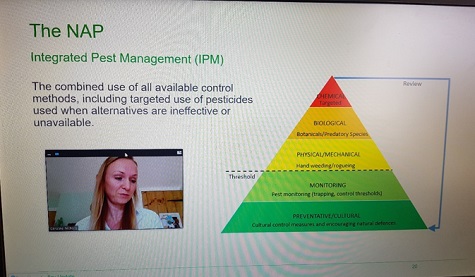
NAP is Part of a bigger Defra 25 year environment plan where they state that they want to improve the UK’s air and water quality and protect our many threatened plants, trees and wildlife species.
The environment plan sets out Defra goals for improving the environment within a generation and leaving it in a better state than we found it. It details how we in government will work with communities and businesses to do this.
This was followed up with an interesting presentation on the work of the Commonwealth War Graves Commission by David Richardson who spoke about how they were changing some of their working practices to comply with government legislation and best practices.
He spoke about the sheer size and logistics of manging all the war graves around the world. He also spoke about the challenges of climate change and how they were addressing new maintenance regimes to help reduce the use pesticides and cleaning products.
Richard spoke in detail about the conservation work they undertake to maintain the war graves and memorials at 23,000 locations, in more than 150 countries and territories.
Over the years, our cemeteries and memorials have evolved naturally – ageing but remaining true to their founding design and purpose. More revolutionary has been the changing landscape within which they are located and the way in which the task of caring for them has changed.
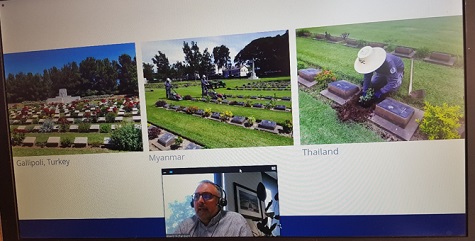
“Many of our cemeteries and memorials were designed by world-renowned architects, sculptors and artists,” said Richard, “and in recent years the significance of our estate has been formally recognised in a number of countries as cemeteries and memorials are listed in increasing numbers or under consideration for World Heritage Site status. With such recognition and protection comes additional responsibility and this is why the Commission is implementing a Heritage Strategy to guide its work for the future.”
In total the commission employ 950 gardeners to manage cemeteries worldwide. Headstones are treated with biocide annually or when discoloration is unacceptable. Lawn and shrub planted areas are kept immaculate with a robust maintenance regime. Since 2019 the War Graves Commission has utilised the help of a (Performance Quality Assurance) App. That keeps records of the condition and work schedules required for each grave. This year they have conducted over 2300 surveys alone with the aim to maintaining a score of around 80% to maintain the standards they set themselves.

Richard continued, “We are regularly assessing the headstones and have a chart we use to help monitor their condition. One of our biggest problems is soil splash which badly stains the base of the headstone. To help reduce the amount of cleaning we continually try to find the right balance of planting material to help reduce soil splash issues. Trying to find the right plant can be difficult especially when you are dealing with some many variable climatic conditions. Each country has its own set of legislation to work to.”
I really enjoyed Richard’s presentation and with Remembrance Day (11th November ) only a couple of weeks away we must be more aware of the remarkable job the War Graves Commission do keep these sites in such good condition.
We then had an interesting presentation by Alister Leggatt, from Water UK who spoke about the issues facing all the water companies (24 at the last count) who are responsible for delivering something we often take for granted. These companies must comply with some of the toughest, most stringent water quality targets in the world.

These companies must work in a five-year planning time frame currently working to AMP7 (2020-2025). Which comes with a 51-billion-pound investment for these companies to further reduce pollution and continue to improve water quality while at the same time reduce customers’ costs and still bring in a profit for their shareholders.
Alister went on say one of their biggest challenges other than repairs is monitoring and policing water pollution. The following graph indicates the level of contamination being found in our rivers today above the drinking water standard.

He then talked about a couple of case studies of noncompliance where a couple of polluters were still using Carbendazim which was banned in 2017. Traces of the pesticide were found in three catchment areas and the perpetrators were identified. The water company provided evidence to HSE, local authorities, the Environment Agency and other relevant agencies, but to date failed to get any enforcement action from any of these organisations.
This is something that the Amenity Forum has been pushing for, for a long time. It is also part of the new National Action Plan that Defra are pursuing to ensure that appropriate enforcement agency is in place to deal with these acts of noncompliance and pollution of water bodies.
The next group of speakers considered integrated approaches to help manage our landscape assets. These included
- The Lawncare Sector - Richard Salmon, UK Lawncare Association
- Landscaping - Wayne Grills, BALI
- Invasive Weeds Management - Chris Oliver, Japanese Knotweed Solutions
The morning’s programme ended with a joint presentation by Jim Croxton of BIGGA and Jason Booth of GMA, on the specific needs for better education and training in the sports turf sectors.

They both spoke about the future needs of the industry, discussing the work both organisations are undertaking to improve the variety and quality of their training and education services, working closely with National Governing Bodies (NGB) of the sports they deal with. At the same time they are both continuing to improve the services they can offer their members.
After lunch the conference reconvened for the final three guest speakers who gave a look into new ways of controlling pests and diseases with the application of new scientific intervention ways of working.
First up was Sophie Hocking, from the University of Swansea who spoke about the Life Cycle Assessment of Japanese Knotweed and ways it can be managed. Her work is a continuation of a lot of work done by Dr Daniel Jones who instigated some Japanese Knotweed trials in Wales in 2012. After years of research both have come to understand better ways to control this invasive weed.
It would seem from the research data that the use of Glysophate directly injected in the stems of the plant offers one of the best outcomes in terms of the plant itself being responsible for translocating the chemical deep down into its rhizomic root structure. This is more effective than perhaps other means such as burial, covering or canopy spraying. However, each and every site offers a specific set of issues when it comes to managing Japanese Knotweed such as proximity near to water, properties, roads, wildlife and people.
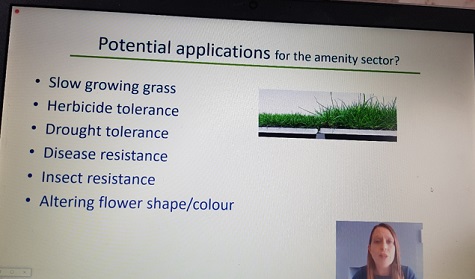
Penny Hundleby, senior scientist at the John Innes Centre, Norwich spoke next. She is actively engaged in GM and Genome-editing of brassica crops and has a keen interest in following the EU regulatory debate surrounding such crops. She gave us an insight into the work she is doing, speaking about the possible breeding of more targeted resistant plant material that could potentially be more resistant to pest and disease in the coming years.
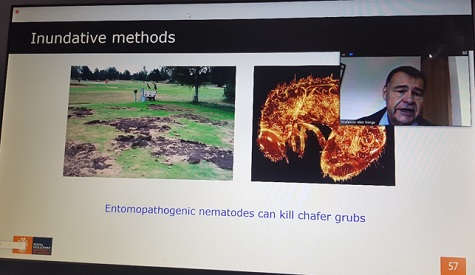
This was followed by the equally knowledgeable Dr Alan Gange from the Royal Holloway University of London, who gave a talk about potential methods of controlling weeds, pests and diseases by the use of their natural enemies. He spoke of using nematodes to control chafer grubs and cranefly larvae, which many groundsmen are now using to control these pests.
While on the subject of academia and the work many of his students are studying, Alan did say we as an industry should do more to share these academic studies. Empowering people with this knowledge can only be a good thing for our industry.
After five-hours in front of the screen, we had the final presentation of the day, by my good friend Keith Kent, recently retired head groundsman of Twickenham Stadium, home to the RFU and England Rugby Team.

Keith gave an excellent presentation on his past fifty plus years working in the sports turf industry talking about all the changes and innovations he has seen over the years. Back when he started in the late 1970s football pitches were lucky to have any grass on them come December! However, with the introduction of better equipment particularly the invention of the Verti-drain deep tine aerator in the early 1980s, which was soon followed by new pitch constructions using more sand dominant rootzones, we finally began to see a vast improvement in playing surfaces.

Keith then spoke about the development of lighting rigs, with the first being seen at Sunderland FC in 2002. Since then we have seen many more advancements in turf culture practices. Today we have a plethora of machinery, products and services to help the highly motivated educated grounds professionals.

As usual the Amenity Forum delivered a very rich and informative set of presentations, delivered by a great group of industry professionals. John Moverley and his team must be applauded in managing to get this conference up and running especially during these unparalleled times. They took a great gamble and I believe pulled it off. I was told by John that we had over 180 plus delegates signed up for the conference. I believe the system worked really well, with all the speakers delivering a great range of topics that were topical and thought provoking.
I did very much miss attending a live conference though, where you usually get great opportunities to meet many fellow practitioners. Let’s hope by next year services will be resumed back to normal.